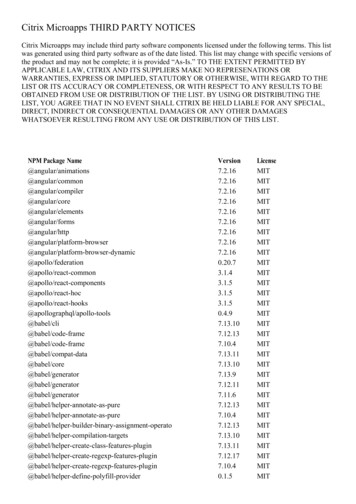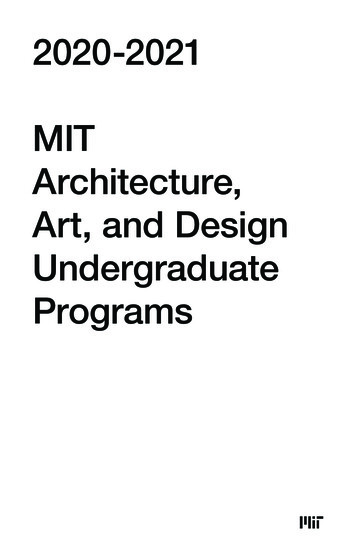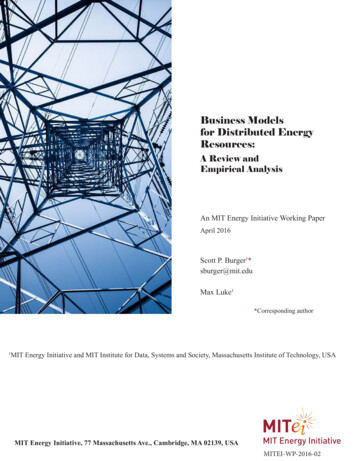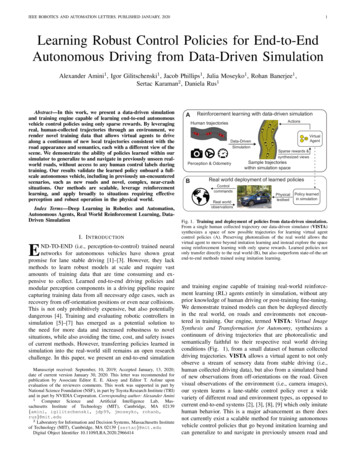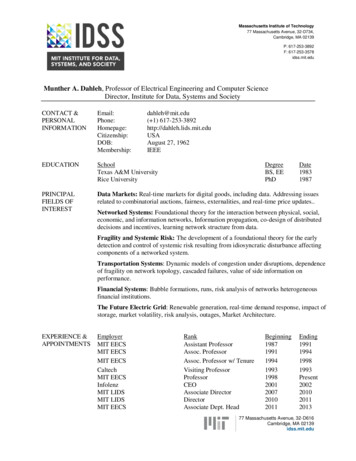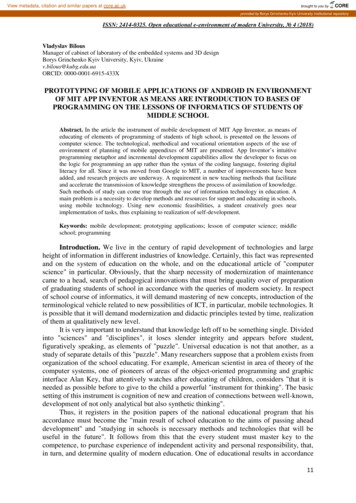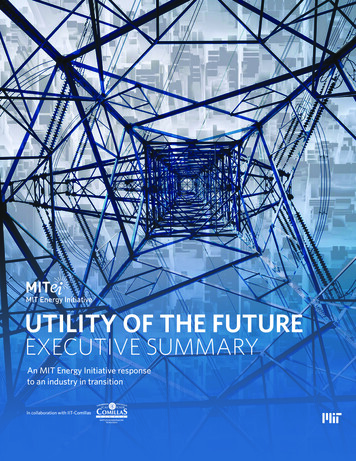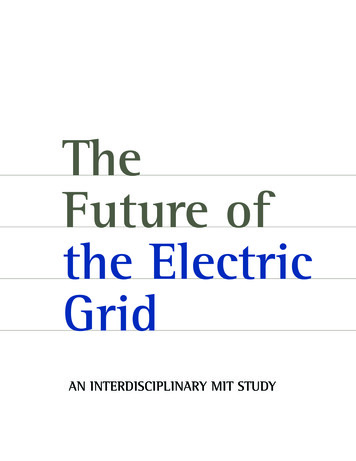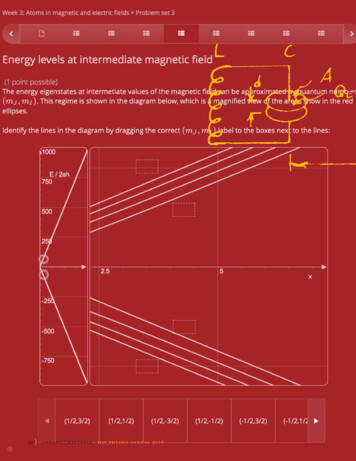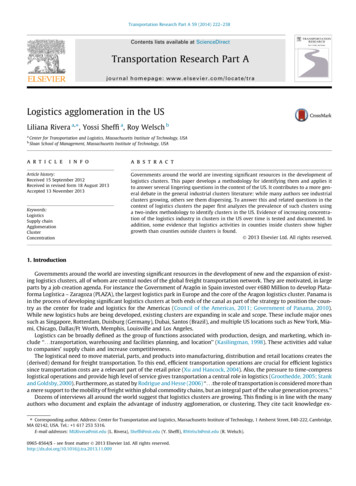
Transcription
Chapter OrganizationIntroductionExchange Rates and International TransactionsThe Foreign Exchange MarketThe Demand for Foreign Currency AssetsEquilibrium in the Foreign Exchange MarketInterest Rates, Expectations, and EquilibriumSummaryCopyright 2003 Pearson Education, Inc.Slide 13-1
IntroductionExchange rates are important because they enable usto translate different counties’ prices into comparableterms.Exchange rates are determined in the same way asother asset prices.The general goal of this chapter is to show: How exchange rates are determined The role of exchange rates in international tradeCopyright 2003 Pearson Education, Inc.Slide 13-2
Exchange Rates andInternational TransactionsAn exchange rate can be quoted in two ways: Direct– The price of the foreign currency in terms of dollars Indirect– The price of dollars in terms of the foreign currencyCopyright 2003 Pearson Education, Inc.Slide 13-3
Exchange Rates andInternational TransactionsTable 13-1: Exchange Rate QuotationsCopyright 2003 Pearson Education, Inc.Slide 13-4
Exchange Rates andInternational TransactionsDomestic and Foreign Prices If we know the exchange rate between two countries’currencies, we can compute the price of one country’sexports in terms of the other country’s money.– Example: The dollar price of a 50 sweater with a dollarexchange rate of 1.50 per pound is (1.50 / ) x ( 50) 75.Copyright 2003 Pearson Education, Inc.Slide 13-5
Exchange Rates andInternational Transactions Two types of changes in exchange rates:– Depreciation of home country’s currency– A rise in the home currency prices of a foreign currency– It makes home goods cheaper for foreigners and foreign goodsmore expensive for domestic residents.– Appreciation of home country’s currency– A fall in the home price of a foreign currency– It makes home goods more expensive for foreigners andforeign goods cheaper for domestic residents.Copyright 2003 Pearson Education, Inc.Slide 13-6
Exchange Rates andInternational TransactionsExchange Rates and Relative Prices Import and export demands are influenced by relativeprices. Appreciation of a country’s currency:– Raises the relative price of its exports– Lowers the relative price of its imports Depreciation of a country’s currency:– Lowers the relative price of its exports– Raises the relative price of its importsCopyright 2003 Pearson Education, Inc.Slide 13-7
Exchange Rates andInternational TransactionsTable 13-2: / Exchange Rates and the Relative Price of AmericanDesigner Jeans and British SweatersCopyright 2003 Pearson Education, Inc.Slide 13-8
The Foreign Exchange MarketExchange rates are determined in the foreignexchange market. The market in which international currency trades takeplaceThe Actors The major participants in the foreign exchange marketare:– Commercial banks– International corporations– Nonbank financial institutions– Central banksCopyright 2003 Pearson Education, Inc.Slide 13-9
Exchange Rates andInternational Transactions Interbank trading– Foreign currency trading among banks– It accounts for most of the activity in the foreignexchange market.Copyright 2003 Pearson Education, Inc.Slide 13-10
Exchange Rates andInternational TransactionsCharacteristics of the Market The worldwide volume of foreign exchange trading isenormous, and it has ballooned in recent years. New technologies, such as Internet links, are usedamong the major foreign exchange trading centers(London, New York, Tokyo, Frankfurt, andSingapore). The integration of financial centers implies that therecan be no significant arbitrage.– The process of buying a currency cheap and selling itdear.Copyright 2003 Pearson Education, Inc.Slide 13-11
Exchange Rates andInternational Transactions Vehicle currency– A currency that is widely used to denominateinternational contracts made by parties who do notreside in the country that issues the vehicle currency.– Example: In 2001, around 90% of transactions between banksinvolved exchanges of foreign currencies for U.S. dollars.Copyright 2003 Pearson Education, Inc.Slide 13-12
Exchange Rates andInternational TransactionsSpot Rates and Forward Rates Spot exchange rates– Apply to exchange currencies “on the spot” Forward exchange rates– Apply to exchange currencies on some future date at aprenegotiated exchange rate Forward and spot exchange rates, while not necessarilyequal, do move closely together.Copyright 2003 Pearson Education, Inc.Slide 13-13
Exchange Rates andInternational TransactionsFigure 13-1: Dollar/Pound Spot and Forward Exchange Rates,1981-2001Copyright 2003 Pearson Education, Inc.Slide 13-14
Exchange Rates andInternational TransactionsForeign Exchange Swaps Spot sales of a currency combined with a forwardrepurchase of the currency. They make up a significant proportion of all foreignexchange trading.Copyright 2003 Pearson Education, Inc.Slide 13-15
Exchange Rates andInternational TransactionsFutures and Options Futures contract– The buyer buys a promise that a specified amount offoreign currency will be delivered on a specified date inthe future. Foreign exchange option– The owner has the right to buy or sell a specifiedamount of foreign currency at a specified price at anytime up to a specified expiration date.Copyright 2003 Pearson Education, Inc.Slide 13-16
The Demand forForeign Currency AssetsThe demand for a foreign currency bank deposit isinfluenced by the same considerations that influencethe demand for any other asset.Assets and Asset Returns Defining Asset Returns– The percentage increase in value an asset offers oversome time period. The Real Rate of Return– The rate of return computed by measuring asset valuesin terms of some broad representative basket of productsthat savers regularly purchase.Copyright 2003 Pearson Education, Inc.Slide 13-17
The Demand forForeign Currency AssetsRisk and Liquidity Savers care about two main characteristics of an assetother than its return:– Risk– The variability it contributes to savers’ wealth– Liquidity– The ease with which it can be sold or exchanged for goodsCopyright 2003 Pearson Education, Inc.Slide 13-18
The Demand forForeign Currency AssetsInterest Rates Market participants need two pieces of information inorder to compare returns on different deposits:– How the money values of the deposits will change– How exchange rates will change A currency’s interest rate is the amount of thatcurrency an individual can earn by lending a unit ofthe currency for a year.– Example: At a dollar interest rate of 10% per year, thelender of 1 receives 1.10 at the end of the year.Copyright 2003 Pearson Education, Inc.Slide 13-19
The Demand forForeign Currency AssetsFigure 13-2: Interest Rates on Dollar and Deutschemark Deposits,1975-1998Copyright 2003 Pearson Education, Inc.Slide 13-20
The Demand forForeign Currency AssetsExchange Rates and Asset Returns The returns on deposits traded in the foreign exchangemarket depend on interest rates and expected exchangerate changes. In order to decide whether to buy a euro or a dollardeposit, one must calculate the dollar return on a eurodeposit.Copyright 2003 Pearson Education, Inc.Slide 13-21
The Demand forForeign Currency AssetsA Simple Rule The dollar rate of return on euro deposits isapproximately the euro interest rate plus the rate ofdepreciation of the dollar against the euro.– The rate of depreciation of the dollar against the euro isthe percentage increase in the dollar/euro exchange rateover a year.Copyright 2003 Pearson Education, Inc.Slide 13-22
The Demand forForeign Currency Assets The expected rate of return difference between dollarand euro deposits is:R - [R (Ee / - E / )/E / ] R - R - (Ee / -E / )/E / (13-1)where:R interest rate on one-year dollar depositsR today’s interest rate on one-year euro depositsE / today’s dollar/euro exchange rate (number ofdollars per euro)Ee / dollar/euro exchange rate (number of dollars pereuro) expected to prevail a year from todayCopyright 2003 Pearson Education, Inc.Slide 13-23
The Demand forForeign Currency Assets When the difference in Equation (13-1) is positive,dollar deposits yield the higher expected rate of return.When it is negative, euro deposits yield the higherexpected rate of return.Copyright 2003 Pearson Education, Inc.Slide 13-24
The Demand forForeign Currency AssetsTable 13-3: Comparing Dollar Rates of Return on Dollar andEuro DepositsCopyright 2003 Pearson Education, Inc.Slide 13-25
The Demand forForeign Currency AssetsReturn, Risk, and Liquidity in the Foreign ExchangeMarket The demand for foreign currency assets depends notonly on returns but on risk and liquidity.– There is no consensus among economists about theimportance of risk in the foreign exchange market.– Most of the market participants that are influenced byliquidity factors are involved in international trade.– Payments connected with international trade make up a verysmall fraction of total foreign exchange transactions. Therefore, we ignore the risk and liquidity motives forholding foreign currencies.Copyright 2003 Pearson Education, Inc.Slide 13-26
Equilibrium in theForeign Exchange MarketInterest Parity: The Basic Equilibrium Condition The foreign exchange market is in equilibrium whendeposits of all currencies offer the same expected rateof return. Interest parity condition– The expected returns on deposits of any two currenciesare equal when measured in the same currency.– It implies that potential holders of foreign currencydeposits view them all as equally desirable assets.– The expected rates of return are equal when:R R (Ee / - E / )/E / Copyright 2003 Pearson Education, Inc.(13-2)Slide 13-27
Equilibrium in theForeign Exchange MarketHow Changes in the Current Exchange Rate AffectExpected Returns Depreciation of a country’s currency today lowers theexpected domestic currency return on foreign currencydeposits. Appreciation of the domestic currency today raises thedomestic currency return expected of foreign currencydeposits.Copyright 2003 Pearson Education, Inc.Slide 13-28
Equilibrium in theForeign Exchange MarketTable 13-4: Today’s Dollar/Euro Exchange Rate and the Expected DollarReturn on Euro Deposits When Ee / 1.05 per EuroCopyright 2003 Pearson Education, Inc.Slide 13-29
Equilibrium in theForeign Exchange MarketFigure 13-3: The Relation Between the Current Dollar/Euro Exchange Rateand the Expected Dollar Return on Euro DepositsToday’s dollar/euroexchange rate, E / 1.071.051.031.021.000.031Copyright 2003 Pearson Education, Inc.0.050 0.069 0.079 0.100Expected dollar return oneuro deposits, R (Ee / E / )/(E / )Slide 13-30
Equilibrium in theForeign Exchange MarketThe Equilibrium Exchange Rate Exchange rates always adjust to maintain interestparity. Assume that the dollar interest rate R , the euro interestrate R , and the expected future dollar/euro exchangerate Ee / , are all given.Copyright 2003 Pearson Education, Inc.Slide 13-31
Equilibrium in theForeign Exchange MarketFigure 13-4: Determination of the Equilibrium Dollar/Euro Exchange RateExchange rate, E / E2 / E1 / E3Return ondollar deposits213 / Expected returnon euro depositsR Copyright 2003 Pearson Education, Inc.Rates of return(in dollar terms)Slide 13-32
Interest Rates, Expectations,and EquilibriumThe Effect of Changing Interest Rates on the CurrentExchange Rate An increase in the interest rate paid on deposits of acurrency causes that currency to appreciate againstforeign currencies.– A rise in dollar interest rates causes the dollar toappreciate against the euro.– A rise in euro interest rates causes the dollar todepreciate against the euro.Copyright 2003 Pearson Education, Inc.Slide 13-33
Interest Rates, Expectations,and EquilibriumFigure 13-5: Effect of a Rise in the Dollar Interest RateExchange rate, E / E1 / Dollar return1E2 / 1'2Expectedeuro returnR 1 Copyright 2003 Pearson Education, Inc.R 2 Rates of return(in dollar terms)Slide 13-34
Interest Rates, Expectations,and EquilibriumFigure 13-6: Effect of a Rise in the Euro Interest RateExchange rate, E / Dollar returnRise in eurointerest rateE2 / 2E1 / 1Expectedeuro returnR Copyright 2003 Pearson Education, Inc.Rates of return(in dollar terms)Slide 13-35
Interest Rates, Expectations,and EquilibriumThe Effect of Changing Expectations on the CurrentExchange Rate A rise in the expected future exchange rate causes arise in the current exchange rate. A fall in the expected future exchange rate causes afall in the current exchange rate.Copyright 2003 Pearson Education, Inc.Slide 13-36
SummaryExchange rates play a role in spending decisionsbecause they enable us to translate differentcountries’ prices into comparable terms.A depreciation (appreciation) of a country’s currencyagainst foreign currencies makes its exports cheaper(more expensive) and its imports more expensive(cheaper).Exchange rates are determined in the foreignexchange market.Copyright 2003 Pearson Education, Inc.Slide 13-37
SummaryAn important category of foreign exchange trading isforward trading.The exchange rate is most appropriately thought of asbeing an asset price itself.The returns on deposits traded in the foreignexchange market depend on interest rates andexpected exchange rate changes.Copyright 2003 Pearson Education, Inc.Slide 13-38
SummaryEquilibrium in the foreign exchange market requiresinterest parity. For given interest rates and a given expectation of thefuture exchange rate, the interest parity condition tellsus the current equilibrium exchange rate.A rise in dollar (euro) interest rates causes the dollarto appreciate (depreciate) against the euro.Today’s exchange rate is altered by changes in itsexpected future level.Copyright 2003 Pearson Education, Inc.Slide 13-39
This document was created with Win2PDF available at http://www.daneprairie.com.The unregistered version of Win2PDF is for evaluation or non-commercial use only.
Foreign Exchange Market Interest Parity: The Basic Equilibrium Condition The foreign exchange market is in equilibrium when deposits of all currencies offer the same expected rate of return. Interest parity condition -The expected returns on deposits of any two currencies are equal when measured in the same currency.
